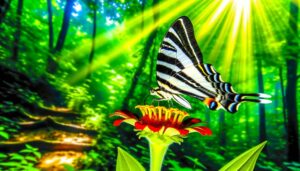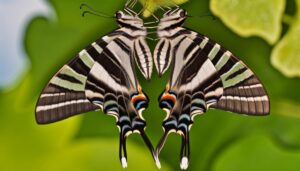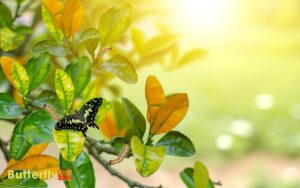7 Must-Have Swallowtail Butterfly Plants for Sale
Swallowtail butterfly plants, such as milkweed, are available for purchase from various nurseries and online retailers. These essential nectar sources feature vibrant orange flower clusters that attract a wide array of pollinators, including butterflies, bees, and beneficial insects.
For best growth, plant them in well-drained, loamy soil with 6 hours of direct sunlight and guarantee consistent moisture without waterlogging. Regular deadheading promotes continuous blooming, supporting biodiversity and the lifecycle of monarch butterfly larvae.
By selecting this plant, you enhance your garden's ecological balance and contribute to the survival of endangered species. Discover more about ideal growing conditions and maintenance techniques.
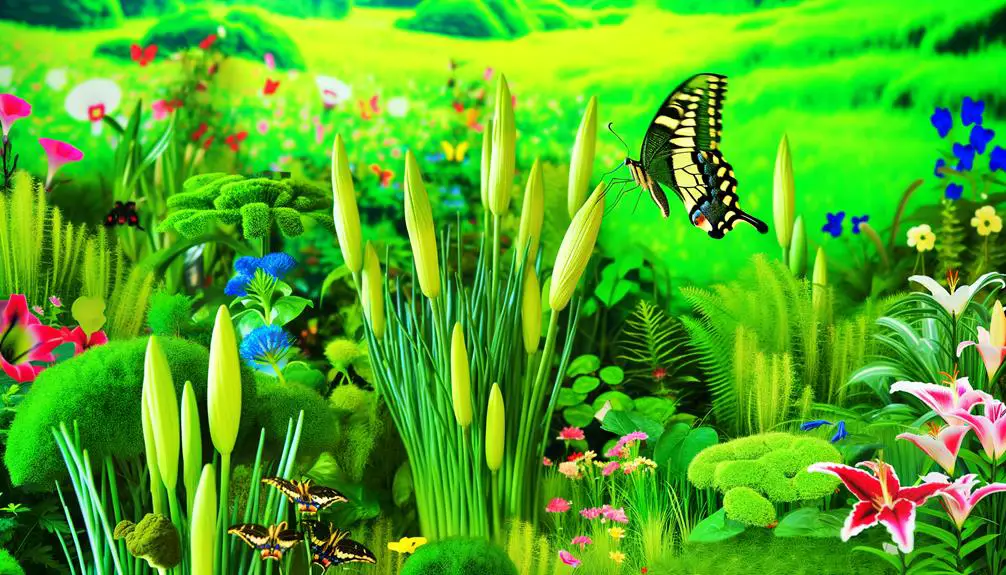
Key Takeaways
- Look for nurseries offering Swallowtail Butterfly plants with well-drained soil requirements.
- Choose plants that thrive in 6 hours of daily direct sunlight.
- Ensure the plant is a suitable host for monarch butterfly larvae.
- Select varieties enriched with compost or organic matter for enhanced growth.
Benefits of Swallowtail Butterfly Plant
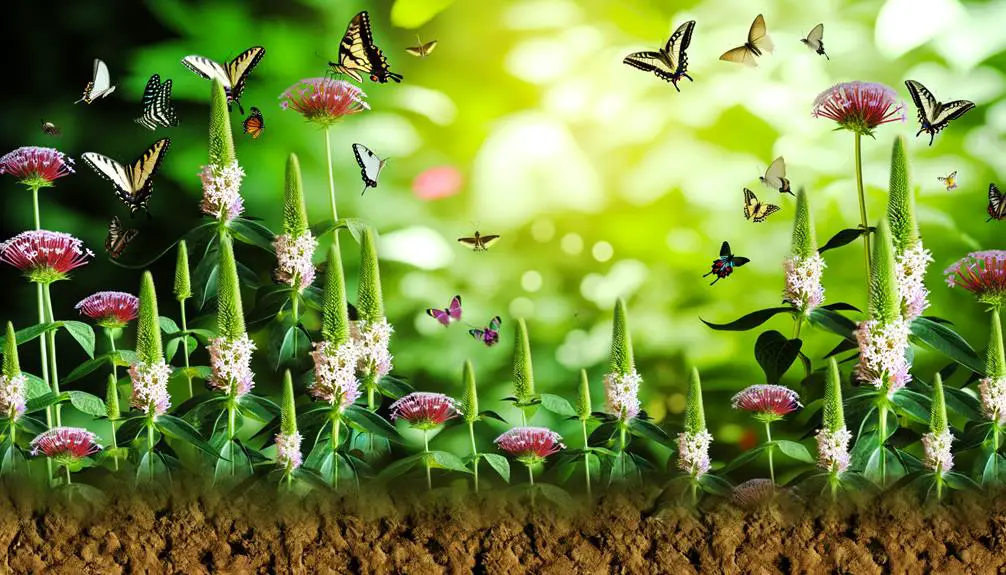
The Swallowtail Butterfly Plant, scientifically known as *Asclepias tuberosa*, offers numerous ecological benefits, including attracting pollinators such as butterflies, bees, and other beneficial insects to your garden.
This perennial herbaceous plant, characterized by its vibrant orange clusters of flowers, serves as a crucial nectar source. The plant's deep taproot system improves soil structure and prevents erosion.
Additionally, *Asclepias tuberosa* plays an essential role in the life cycle of the monarch butterfly (*Danaus plexippus*) as a host plant for its larvae. Cultivating this plant not only enhances biodiversity but also supports endangered species.
For peak growth, guarantee regular deadheading to promote continuous blooming and consider integrating it into pollinator-friendly landscapes to maximize ecological benefits.
Ideal Growing Conditions
For ideal growth, the Swallowtail Butterfly Plant requires a balanced exposure to both sunlight and partial shade, ensuring it receives at least six hours of direct light daily.
The plant thrives in well-drained, loamy soil enriched with organic matter to support its nutrient needs.
Regular watering is essential, but the soil must offer excellent drainage to prevent waterlogging and root rot.
Sunlight and Shade Balance
Achieving the ideal growth of Swallowtail Butterfly plants necessitates a careful balance of sunlight and shade, with these plants thriving best in environments that offer dappled sunlight or partial shade.
This nuanced light requirement guarantees that the foliage receives sufficient photosynthetic energy while avoiding the detrimental effects of excessive direct sunlight.
Best positioning involves placing the plant in areas where it can receive approximately 4-6 hours of indirect sunlight daily. Morning sunlight, coupled with afternoon shade, is particularly beneficial.
Overexposure to intense sunlight can lead to leaf scorch, whereas insufficient light may hinder growth and flowering.
Regular monitoring and adjustments to the light exposure, based on seasonal changes, will promote robust health and vibrant blooms, essential for attracting butterflies.
Soil Type Needs
Understanding the light requirements is only one aspect of fostering healthy Swallowtail Butterfly plants, as selecting the appropriate soil type is equally pivotal for their ideal growth.
These plants thrive in well-drained, loamy soil enriched with organic matter, ensuring adequate aeration and nutrient availability. The ideal pH range lies between 6.0 and 7.0, slightly acidic to neutral, which facilitates nutrient uptake and root health.
Incorporating compost or well-rotted manure can greatly enhance soil fertility and structure. For those who desire the liberty of container gardening, using a high-quality potting mix with perlite or vermiculite will provide the necessary drainage and moisture retention.
Ensuring these soil conditions will contribute to the robust development and flourishing of Swallowtail Butterfly plants.
Watering and Drainage
Proper watering and effective drainage are essential for maintaining the ideal health and vigor of Swallowtail Butterfly plants. These plants thrive under specific moisture conditions that balance hydration and aeration.
To achieve best growth:
- Consistent Moisture: Verify the soil is consistently moist but not waterlogged; overwatering can lead to root rot.
- Well-Draining Soil: Utilize a well-draining soil mix to prevent water from stagnating around the roots.
- Watering Frequency: Water the plants deeply once a week, adjusting frequency based on weather conditions and soil moisture levels.
Planting Instructions
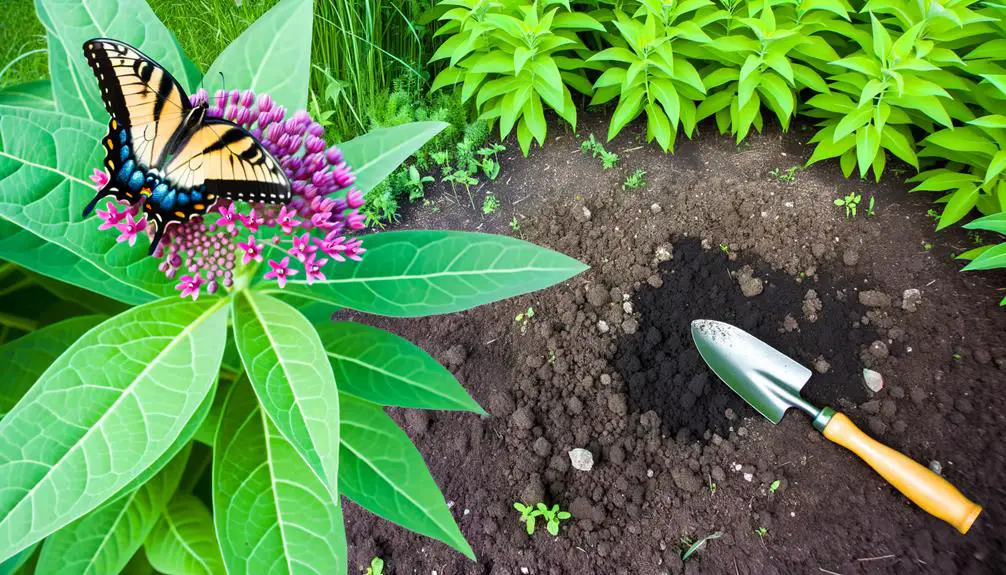
To successfully plant the Swallowtail Butterfly Plant, select a location with well-draining soil and full sun exposure. Begin by preparing the soil, incorporating organic matter to enhance fertility. The ideal planting depth is such that the root ball is level with the ground surface. Space plants approximately 18-24 inches apart to allow adequate air circulation and growth.
| Planting Step | Description |
|---|---|
| Soil Preparation | Enrich with compost or organic matter |
| Planting Depth | Root ball level with the ground surface |
| Spacing | 18-24 inches apart for ideal growth |
| Sunlight Requirement | Full sun exposure, minimum 6 hours of direct sunlight |
Water the plant thoroughly after planting to settle the soil and remove air pockets. Ascertain consistent moisture without waterlogging the soil.
Maintenance Tips
Regular maintenance of the Swallowtail Butterfly Plant involves strategic pruning, vigilant pest management, and meticulous watering practices to guarantee robust growth and vibrant blooms.
Pruning should be undertaken to remove dead or damaged stems, which promotes new growth and prevents disease.
Pest management requires regular inspection for aphids, caterpillars, and other insects, with organic or chemical treatments applied as necessary.
Watering should be consistent yet moderate to avoid root rot, ensuring the soil remains moist but not waterlogged.
Key maintenance tips include:
- Pruning: Remove dead foliage to stimulate new growth.
- Pest management: Regularly inspect for and address insect infestations.
- Watering: Maintain consistent soil moisture without overwatering.
Attracting Swallowtail Butterflies
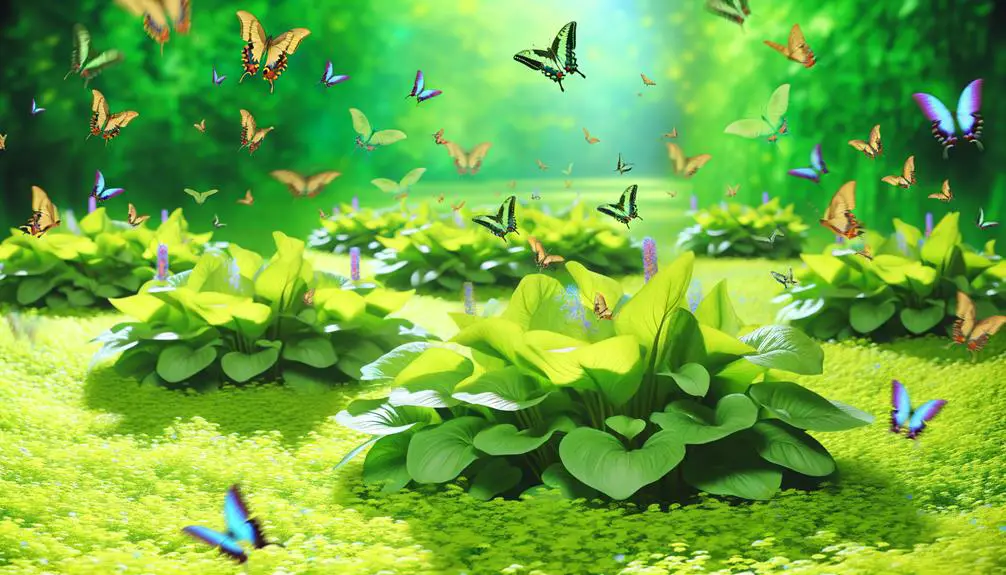
To attract Swallowtail butterflies effectively, it is essential to select appropriate host plants such as dill, fennel, and parsley, which cater to their larval stage.
Additionally, creating an ideal habitat involves ensuring a sunny location, providing a water source, and incorporating nectar-rich flowers like milkweed and zinnias.
These measures will greatly enhance the likelihood of Swallowtail butterflies frequenting and thriving in your garden.
Choosing Host Plants
Selecting appropriate host plants is crucial for attracting Swallowtail butterflies, as these plants provide essential nutrients and habitat for the caterpillars during their larval stage. Critical elements in choosing these plants include their nutritional value, phenology, and compatibility with local ecosystems. By incorporating a variety of swallowtail butterfly egglaying plants, gardeners can ensure a continuous food source for emerging larvae and support healthy butterfly populations. Native species are often the best choice, as they are well-adapted to local environmental conditions and promote ecological balance. Additionally, selecting plants with staggered blooming periods can provide nectar for adult butterflies throughout the season.
Key host plants for Swallowtail butterflies include:
- Dill (Anethum graveolens): Thrives in well-drained soil, full sunlight, and provides a rich source of essential oils.
- Parsley (Petroselinum crispum): Requires moist, nutrient-rich soil and partial to full sunlight.
- Fennel (Foeniculum vulgare): Grows well in poor, dry soils and full sunlight, providing a robust food source.
Selecting these host plants guarantees a thriving environment for Swallowtail caterpillars.
Creating Ideal Habitat
Beyond choosing the right host plants, establishing an ideal habitat for Swallowtail butterflies involves creating a garden environment that supports all stages of their lifecycle, including appropriate nectar sources, shelter, and microclimatic conditions. Nectar sources should include a variety of flowering plants to guarantee a continuous food supply. Shelter, in the form of shrubs and tall grasses, provides protection from predators and harsh weather. Microclimatic conditions can be optimized by positioning plants to guarantee sun exposure and moisture retention.
| Aspect | Recommendations |
|---|---|
| Nectar Sources | Buddleia, Lantana, and Zinnia |
| Shelter | Dense shrubs, tall grasses |
| Microclimate | Sunlit areas, mulching for moisture |
Companion Plants
Integrating companion plants such as fennel, dill, and parsley can greatly enhance the ecological balance and overall health of a garden where Swallowtail Butterflies are cultivated. These plants offer essential resources and benefits that support the life cycle of Swallowtails.
Key advantages include:
- Nutrient Diversification: Companion plants contribute to soil health by diversifying nutrient profiles and improving fertility.
- Pest Control: Dill and parsley act as natural pest repellents, reducing the need for chemical interventions.
- Habitat Structure: These plants provide shelter and breeding grounds, fostering a thriving butterfly population.
Strategically incorporating these plants can lead to a more resilient and vibrant garden ecosystem.
Seasonal Care
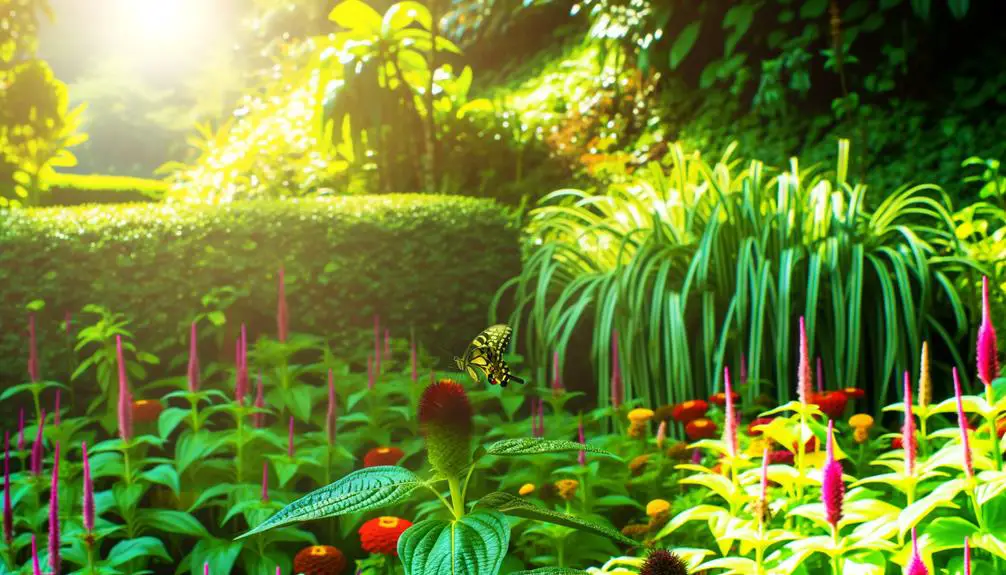
Effective cultivation of Swallowtail Butterfly plants necessitates a thorough understanding of seasonal care practices to guarantee ideal growth and sustainability throughout the year.
During spring, prioritize soil aeration and the application of a balanced, slow-release fertilizer to promote robust root development.
In summer, make certain of consistent watering while avoiding waterlogged conditions, and provide partial shade to mitigate heat stress.
Autumn care involves pruning dead foliage and applying mulch to retain soil moisture and temperature.
Winterizing these plants requires covering them with frost cloths to prevent freeze damage in colder regions.
Regular monitoring and adjusting to specific climatic conditions will make certain that Swallowtail Butterfly plants thrive, offering a vibrant display and supporting butterfly populations year-round.
Common Pests and Solutions
Swallowtail Butterfly plants are susceptible to various pests, including aphids, caterpillars, and spider mites, which can greatly hinder their growth and health. Effective pest management is essential for maintaining the plant's health and ensuring ideal conditions for butterfly attraction.
To manage these pests, consider the following solutions:
- Neem Oil: An organic pesticide that disrupts the lifecycle of pests without harming beneficial insects.
- Insecticidal Soap: Effective against soft-bodied pests like aphids and spider mites by disrupting their cell membranes.
- Handpicking: Regularly inspecting and manually removing larger pests such as caterpillars.
Implementing these strategies will help maintain your Swallowtail Butterfly plant in peak condition, promoting robust growth and butterfly visitation.
Buying Guide

When purchasing a Swallowtail Butterfly plant, consider factors such as cultivar selection, growth requirements, and regional adaptability to guarantee successful cultivation.
Choose cultivars known for their resilience and attractiveness to butterflies, such as Asclepias tuberosa or Aristolochia macrophylla.
Evaluate the plant's specific needs, including soil pH, sunlight exposure, and water requirements. For ideal growth, ascertain well-drained soil with a slightly acidic to neutral pH, and position the plant in full sun to partial shade.
Verify the plant's hardiness zone compatibility with your local climate to ensure it thrives year-round.
Additionally, inspect for disease resistance and pest tolerance to reduce maintenance efforts.
Thoughtful consideration of these criteria will empower your gardening success with Swallowtail Butterfly plants.
Customer Testimonials
Customer testimonials reveal the transformative impact of the Swallowtail Butterfly Plant on diverse garden ecosystems.
Many gardeners have reported significant enhancements in butterfly attraction, noting increased visits from various Papilionidae species.
Additionally, these plants have proven robust under various cultivation conditions, offering consistent growth and vibrant blooms that contribute to overall garden health.
Positive Plant Experiences
Numerous horticultural enthusiasts have reported exceptional growth and vibrant coloration in their gardens after incorporating the Swallowtail Butterfly Plant, attributing these improvements to the plant's resilience and adaptability under various climatic conditions.
This species, scientifically known as *Papilio machaon*, thrives in a range of soil types and demonstrates remarkable tolerance to both drought and humidity.
Customers have noted numerous benefits:
- Enhanced Pollination: Draws in a variety of pollinators, including bees and butterflies.
- Low Maintenance: Requires minimal watering and is resistant to common pests.
- Extended Bloom Period: Offers prolonged flowering from spring through late summer.
These features make it an ideal addition to any diverse horticultural landscape.
Garden Transformation Stories
Gardeners who have integrated the Swallowtail Butterfly Plant into their landscapes frequently share compelling testimonies of transformative experiences, often highlighting the plant's robust adaptability and remarkable contributions to biodiversity.
This plant, Asclepias incarnata, thrives in a range of soil types, from loamy to sandy, and exhibits a high tolerance for both drought and wet conditions.
Customers report substantial improvements in garden ecosystem health, noting increased pollinator visits and enhanced soil fertility.
Cultivation tips emphasize spacing plants 12-24 inches apart to optimize airflow and prevent mildew. Incorporating organic mulch can aid in moisture retention and weed suppression.
Such testimonials underscore the Swallowtail Butterfly Plant's pivotal role in fostering resilient and ecologically vibrant gardens, appealing to those seeking horticultural autonomy.
Butterfly Attraction Success
Horticultural enthusiasts have consistently praised the Swallowtail Butterfly Plant for its unparalleled ability to attract diverse species of butterflies, transforming gardens into vibrant pollinator sanctuaries.
Customers have reported thriving lepidopteran populations, attributing their success to the plant's nectar-rich blossoms and robust resilience.
Key testimonials highlight the plant's efficacy:
- Increased Biodiversity: Users observed an influx of various butterfly species, enhancing ecological diversity.
- Ease of Cultivation: The plant's adaptability to different soil types and minimal maintenance requirements make it ideal for both novice and experienced gardeners.
- Extended Bloom Period: Extended flowering times provide a continuous food source for butterflies.
The Swallowtail Butterfly Plant offers an exceptional solution for those seeking to cultivate a butterfly-friendly haven.
Conclusion
In summary, the Swallowtail Butterfly Plant emerges as a botanical gem, offering ecological benefits and aesthetic appeal.
Cultivated under ideal conditions with meticulous care, this plant flourishes, attracting the illustrious Swallowtail butterflies.
Seasonal maintenance and vigilant pest management guarantee its enduring health.
By adhering to thorough guidelines and informed purchasing decisions, one can transform a garden into a sanctuary of fluttering elegance, harmonizing nature's intricate tapestry with human stewardship.



